#Canadian Regiment of Fencible Infantry
Text
I'm on the website of the Canadian Regiment of Fencible Infantry, which is a War of 1812 historical reenactment group, and in their gallery section there are pictures from 2014 when they went to the White House in costume for the 200th anniversary of the Burning of Washington OH MY GOD
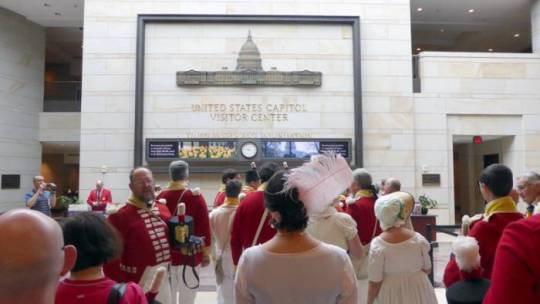
They posed in the front of the White House like this!!

They went on a White House tour dressed like this!!

The tour guide has to be pretty entertained, I'm dying. I cannot stess enough that they are dressed like enemy troops who captured the White House and burned it down in 1814.
Can this even be done anymore?? I never thought that 2014 would look like a comparatively carefree and innocent time.
#war of 1812#burning of washington#redcoats#historical reenactment#living history#historical reenactors#canadian history#canadian regiment of fencible infantry#i can only imagine that today it's No Fun Allowed in the white house#the idiots in 2021 ruined it for everyone#no more pretending to burn down the white house 😔
94 notes
·
View notes
Photo
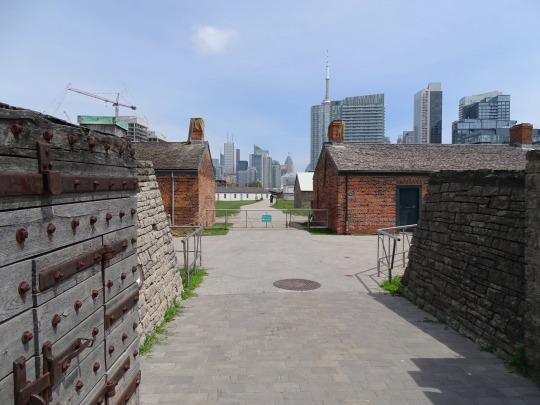
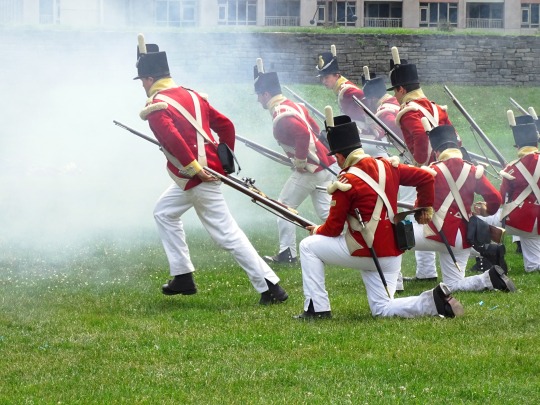
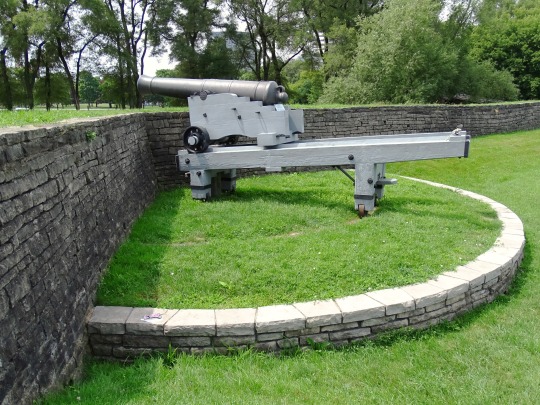

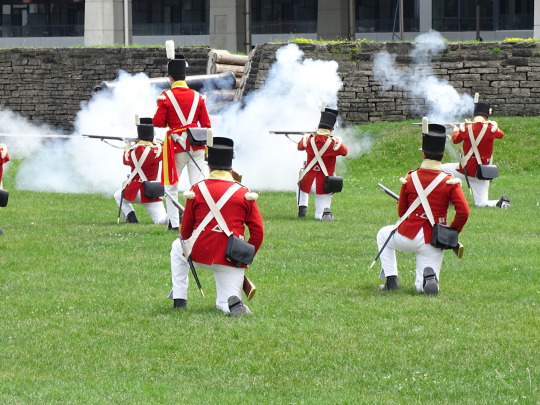
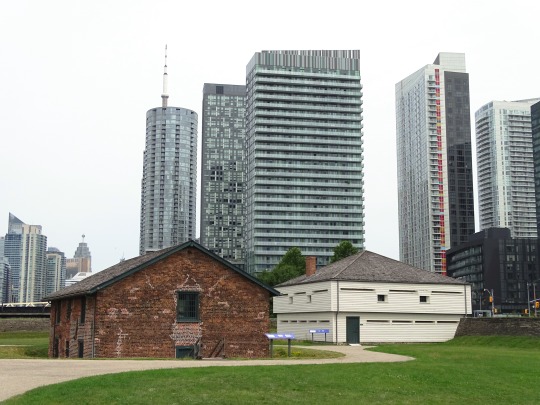
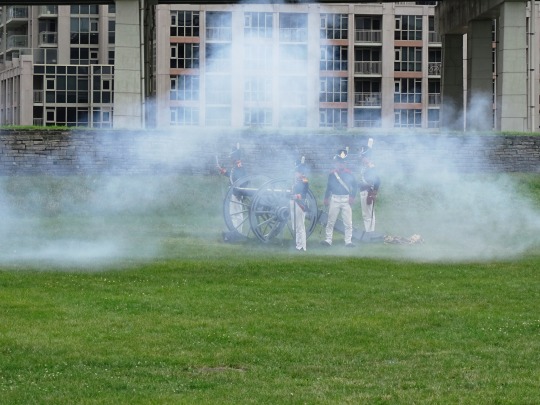

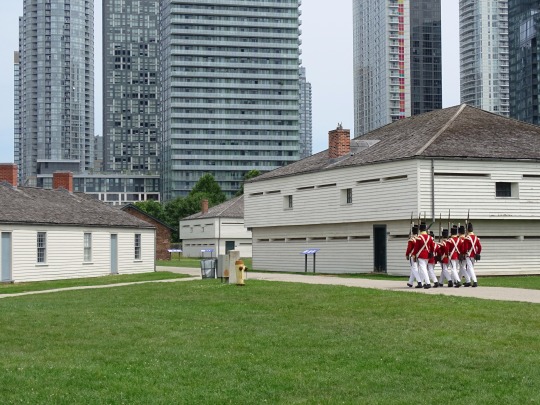

War of 1812: American troops captured York, the capital of Upper Canada, in the Battle of York on April 27, 1813.
#War of 1812#York#captured#Battle of York#27 April 1813#anniversary#US troops#military history#original photography#Toronto#Ontario#Canada#travel#Fort York National Historic Site#cannon#historical reenactment#Canadian Regiment of Fencible Infantry#Fort York Guard Royal Artillery#musketmen#6-pounder field gun#cityscape#architecture#tourist attraction#museum#summer 2018#vacation#uniform
1 note
·
View note
Photo




The War of 1812 Monument, officially titled Triumph Through Diversity (Triomphe grâce à la diversité in French), is a bronze and stone memorial, located at Parliament Hill in Ottawa, Ontario, Canada, Canada's capital. Seven figures - a First Nations fighter, a Métis militiaman, a regular infantryman from the Royal Newfoundland Regiment of Fencible Infantry, a Quebec soldier of the Canadian Voltigeurs being bandaged by a female figure, a Royal Navy marine, and a farmer - represent those who took part on the Canadian side of the War of 1812. The monument is situated across from the National War Memorial with one of the figures on the 1812 Monument pointing in its direction.
Also part of the monument is a maple tree planted in soil taken from 10 Canadian battlefield sites and watered at the dedication with water from six oceans and lakes significant in the War of 1812. The tree symbolizes the Canadian nation that grew out of the effort to defend Canada during the War of 1812.
The Monument was dedicated on 6 November 2014, the 200th anniversary of the war's final battle in Canada, the Battle of Malcolm's Mills.
#war of 1812#1812#canada#canadian#canadian history#19th century#british empire#us history#america#first nations
40 notes
·
View notes
Text
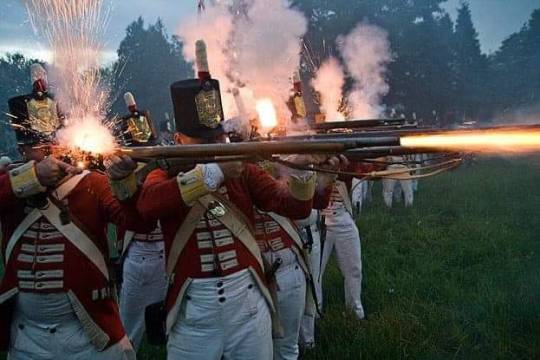
Canadian Regiment of Fencible Infantry historical re-enactment group at a Battle of Crysler's Farm event.
#war of 1812#redcoats#canadian history#dressed to kill#living history#flintlock#black powder#historical reenactment#battle of crysler's farm#crysler's farm#god i wish that were me
51 notes
·
View notes
Photo










British troops invaded Washington, D.C. and during the Burning of Washington the White House, the Capitol and many other buildings are set ablaze on August 24, 1814.
#British troops#invaded#Washington DC#USA#24 August 1814#US history#205th anniversary#architecture#cityscape#War of 1812#travel#vacation#summer 2009#White House#US Capitol#United States Capitol#landmark#tourist attraction#Canadian Regiment of Fencible Infantry#Toronto#Canada#2018#Fort York National Historic Site#Fort York Guard Royal Artillery#Ottawa#100th Regiment#2015
2 notes
·
View notes
Photo
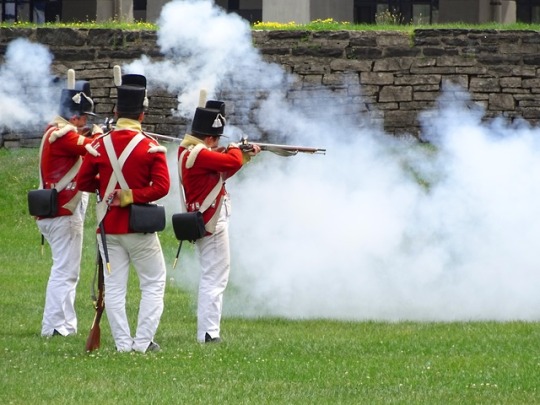
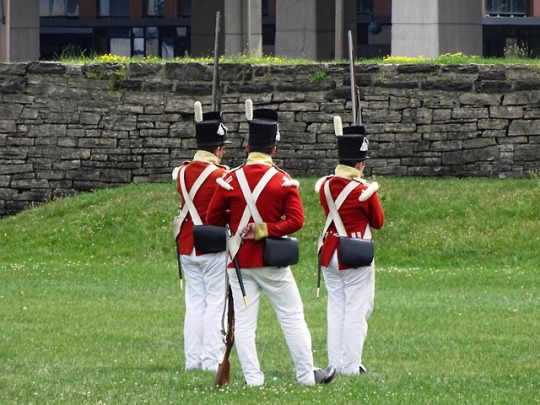
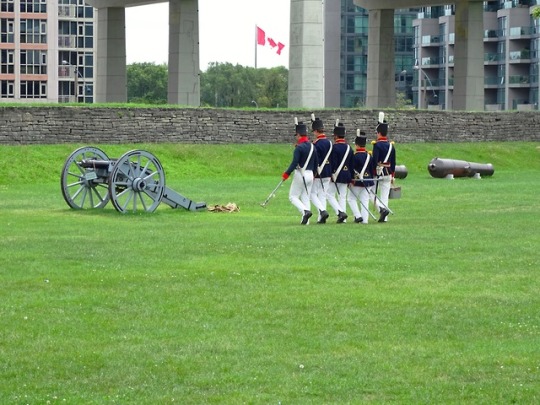




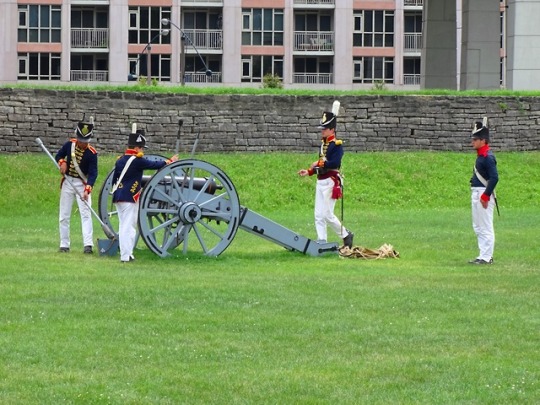
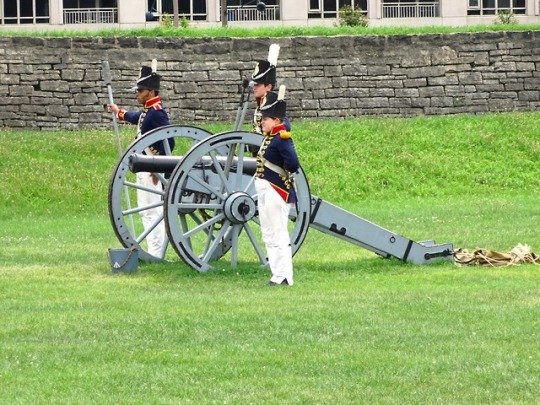
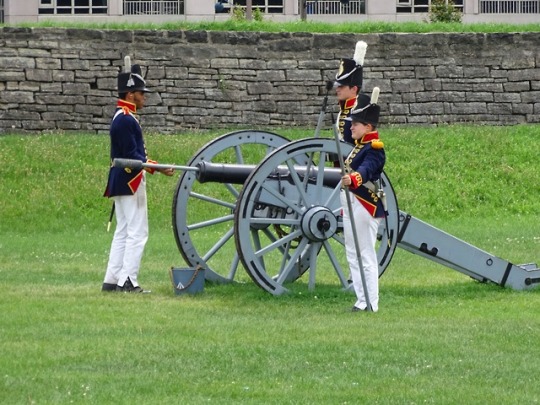
Fort York National Historic Site of Canada, Toronto (No. 8)
Fort York Squad
The Fort York Squad was re-established by the Toronto Historical Board in 1994. Originally, the Guard wore the uniform of the grenadier company of the 8th Regiment of Foot, which was a unit that played a prominent role in the Battle of York in 1813. It now wears the uniform of a battalion company of the Canadian Regiment of Fencible Infantry. This regiment was garrisoned at Fort York in 1815.
The Squad performs daily in conjunction with the Fort York Drums, but it also travels, performing at historic sites across Ontario to promote the fort and at various events in Toronto. The drill performed by the Squad accurately reflects the War of 1812 period, and is taken from original drill manuals used by His Majesty' s forces in England and abroad. Every effort is made to provide an authentic depiction of a squad of soldiers that may have been seen at Fort York in 1815.
The Fort York Squad has competed in the province-wide Fort George Drill competition in Niagara Falls every year since 1999, and has won the competition several times.
Royal Artillery
A significant part of the Fort York Guard, the Royal Artillery detachments man the field guns that are fired daily during the summer months.
The Royal Artillery has been an important part of Fort York since its first construction in 1793. The strength of a fort's artillery often determines the strength of a fort and its ability to repel an attack by land or sea. Fort York has one of Canada's most diverse collections of original guns. This collection dates from the mid-17th century right up to the 1870's, when the British army left Canada. Many of the fort's ordinance are on display around the fort and in a new artillery exhibit in Blockhouse (No. 2).
The Guard's Artillery Detachments fire the fort's reproduction Cohorn mortar, a 1-pounder and a 6-pounder field gun. They wear the Royal Artillery's distinctive blue jackets with yellow regimental lace, along with their unique style shako (caps).
Source
#Fort York National Historic Site of Canada#Fort York National Historic Site#travel#Fort York Heritage Conservation District#Old Fort York#museum#Toronto#Ontario#Canada#summer 2018#original photography#architecture#cityscape#Canadian Regiment of Fencible Infantry#Fort York Guard#Fort York Squad#military re-enactment unit#Brown Bess musket#6-pounder field gun#blue jackets#shako#Fort York Guard Royal Artillery
1 note
·
View note
Photo










War of 1812: American troops captured York, the capital of Upper Canada, in the Battle of York on April 27, 1813.
#Fort York National Historic Site of Canada#Toronto#skyline#architecture#landmark#tourist attraction#War of 1812#us troops#captured#York#Battle of York#27 April 1813#Canada#summer 2018#anniversary#history#Ontario#original photography#Canadian Regiment of Fencible Infantry#Historical reenactment#CN Tower#west gate#Fort York Guard Royal Artillery#6-pounder field gun#indoors#outdoors#museum#uniform#barrack
1 note
·
View note
Photo










Fort York National Historic Site of Canada, Toronto (No. 7)
The Fort York Guard has been a familiar part of Fort York for over seventy-five years, since the fort opened as a national historic site in 1934. It consists of two sub-units, the Squad (musketmen) and the Drums (musicians). The size of the Guard has varied over the years, from a high of 40, to zero between the mid–1980s and 1994.
Each day, the Guard performs a variety of demonstrations for the fort's visitors during the summer months. These include artillery firing, musical demonstrations, drills, and battle tactics performances. For schedules contact Fort York.
The Friends of Fort York accepted full responsibility for running the Guard in 1999 and has gradually increased its size to 23 students in 2010 not including the younger volunteers in the Drums. Plans call for a Guard of 30 for the celebration of the Bicentennial of the War of 1812. For the last decade, The Friends of Fort York have been responsible for the operation of the Guard. This involves their hiring, training, scheduling, deployment, uniforms, and equipment. It consumes a large part of what The Friends earn from different fundraising functions and activities or receives as donations. Putting such a credible and award-winning squad in the field to animate the fort, in a way nothing else could do as appropriately, would not be possible without assistance from the City of Toronto Culture department and various programmes of the Government of Canada to assist with student summer employment.
Fort York Squad
The Fort York Squad was re-established by the Toronto Historical Board in 1994. Originally, the Guard wore the uniform of the grenadier company of the 8th Regiment of Foot, which was a unit that played a prominent role in the Battle of York in 1813. It now wears the uniform of a battalion company of the Canadian Regiment of Fencible Infantry. This regiment was garrisoned at Fort York in 1815.
The Squad performs daily in conjunction with the Fort York Drums, but it also travels, performing at historic sites across Ontario to promote the fort and at various events in Toronto. The drill performed by the Squad accurately reflects the War of 1812 period, and is taken from original drill manuals used by His Majesty' s forces in England and abroad. Every effort is made to provide an authentic depiction of a squad of soldiers that may have been seen at Fort York in 1815.
The Fort York Squad has competed in the province-wide Fort George Drill competition in Niagara Falls every year since 1999, and has won the competition several times.
Source
#Fort York National Historic Site of Canada#Fort York National Historic Site#travel#Fort York Heritage Conservation District#Old Fort York#Toronto#Ontario#Canada#Gardiner Expressway#cityscape#museum#Canadian Regiment of Fencible Infantry#Canadian Fencibles#Fort York Guard#military re-enactment unit#musketmen#Fort York Squad#Brown Bess musket#demonstration#landmark#tourist attraction
0 notes
Photo


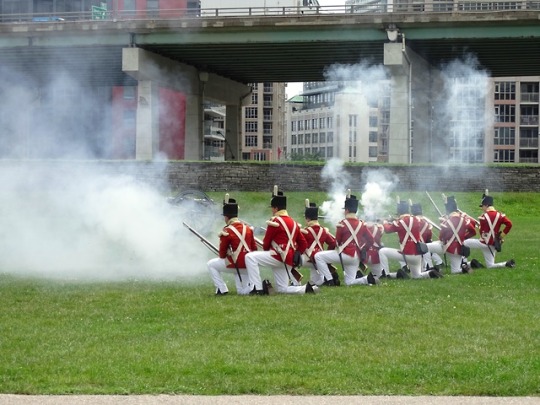







Fort York National Historic Site of Canada, Toronto (No. 6)
The Canadian Regiment of Fencible Infantry, commonly known as the Canadian Regiment or the Canadian Fencibles, saw service in Upper and Lower Canada during the early 19th century, notably during the Anglo-American War of 1812.
The regiment was originally raised in Scotland amongst highlanders keen on emigrating to Canada in 1803-4. The unit was to see service only in British North America. However, misunderstandings regarding the terms of enlistment and rumours that the regiment would be sent to India caused the recruits to mutiny in Glasgow. In response, the men were all discharged in the fall of 1804. Subsequently, the commissioned officers and a skeleton crew of other ranks were sent to re-raise the regiment in the Canadas.
Initially, the commissioned and non-commissioned officers were Scottish while the core of the regiment would be French and English-speaking Canadians. The Scottish roots of the regiment are evident in the regiment's coat of arms with a thistle. The regiment was created in Montreal in 1803, but did not begin recruitment until 1805.
By the start of the War of 1812, the regiment's strength was at 600 men.
The Canadian Fencibles first received scholarly attention when Scottish popular historian John Prebble featured the regiment's 1804 mutiny in his 1975 book Mutiny: Highland Regiments in Revolt. Canadian historian Robert Henderson also explored the history of the unit in a series of articles, several of which appeared in Military Illustrated in 1991. Most recently, Eamonn O'Keeffe authored a book chapter on the regiment's fife and drum corps and band. In an article for Canadian Military History, O'Keeffe also shed light on the inner workings of the regiment through analysis of the court martial of Canadian Fencibles Lieutenant John de Hertel, who was tried for assaulting a fellow officer in Fort York's Blue Barracks in 1815.
Châteauguay (1813)
Crysler's Farm (1813)
Lacolle Mills (1814)
The Canadian Regiment was disbanded in July and August 1816 at Kingston and Montreal. The history and heritage of the regiment, together with its Battle Honours for Châteauguay and Crysler's Farm, are commemorated within the Canadian Army by the Royal 22e Régiment.
It was recreated in 1984 as a military re-enactment unit, continuing to this day with both military and civilian displays, across Canada and the United States. Participating in recreated battles, youth events and festivals across the country, the group's membership continues to grow with new elements, such as civilian portrayals, artillery and naval elements, being added and expanded, regularly.
The Friends of Fort York now hire students to recreate the regiment at Fort York in Toronto, Ontario during the summer months. This group is known as the Fort York Guard. At the Scout Brigade of Fort George each September, the sub-camp for youth of the Cub Scout program also recreate the regiment.
Source: Wikipedia
#Fort York National Historic Site of Canada#Fort York National Historic Site#travel#Fort York Heritage Conservation District#Old Fort York#Toronto#Ontario#Canada#original photography#summer 2018#vacation#Fort York Guard#historical reenactment#Uniform of Canadian Regiment of Fencible Infantry#musketemen#military re-enactment unit#Brown Bess musket#landmark#tourist attraction#Gardiner Expressway#cannon#architecture#demonstration
1 note
·
View note
Text
The Canadian Voltigeurs - Britain’s French-Canadian Light Infantry

As war with the United States threatened in 1812, the British administration in Canada went about raising fresh militia and fencible (essentially local regular) regiments. One such unit were the Canadian Voltigeurs, a unit raised in Quebec from predominantly French Canadians.
While Quebec had been famously seized from France by the British in 1759, French Canadians preferred somewhat moderate British rule to the avowedly anti-French, anti-Catholic attitudes of their southern neighbours. They were instrumental in ensuring Canada remained British during the American Revolution, and again proved themselves in 1812.
The Voltigeurs were commanded by Charles-Michel d'Irumberry de Salaberry, a fearsome officer from a military family. De Salaberry served in the British army in the 1790s, where he acquired a no-nonsense reputation. A fellow officer recounted;
The officers of the 60th Regiment, of which Charles-Michel de Salaberry was Lieutenant, were of different nationalities, English, Prussians, Swiss, Hanoverians, and two French-Canadians, Lieutenants de Salaberry and DesRivières. It was difficult to preserve harmony among them — the Germans especially being passionate, quarrelsome, and duellists. One morning, de Salaberry was sitting at breakfast with some of his brother officers, when one of the Germans entered, and looking at him with an insulting air, said, "I have just come from sending a French Canadian to the other world!" meaning that he had just killed Lt. Thomas-Hippolyte Trottier DesRivières in a duel. De Salaberry sprang like a tiger from his seat; but instantly calming himself, said, "We will finish breakfast, and then you shall have the pleasure of finishing another French Canadian." They fought, as was then the custom, with swords; both were noted for their great skill, and the contest was long and obstinate.
De Salaberry was very young; his antagonist more aged, and a rough bully. The young Canadien received a wound on his forehead, which time never effaced, and as it bled freely and interfered with his sight, friends attempted to stop the conflict; but he would not consent, but binding his handkerchief round his head, recommenced the fight with greater fury. At length his adversary fell mortally wounded.
Under de Salaberry the Voltigeurs would play a role in a number of vital engagements during the War of 1812.

De Salaberry selected members of the leading families of Lower Canada as officers, but their commissions were not confirmed until they had recruited their quota of volunteers (for example, 36 men for Captains, 14 for Lieutenants). Several other officers transferred from units of the British Army stationed in Canada, in the hope that they would gain rank or seniority by the transfer. Most of these officers remained with the Voltigeurs even when these ambitions were not fulfilled.
The ".. men to be enrolled in this corps to be between the age of 17 and 35 years and not below 5 feet 3 inches." Recruiting was brisk; in addition to a bounty of £4, the recruits were promised a grant of 50 acres (200,000 m2) of land on discharge. Almost all the soldiers and most of the officers were French-speaking, which led to the unit being widely known as the Voltigeurs, a French word meaning "vaulter" or "leaper", and given to light infantry units in the French Army.

The Voltigeurs wore grey uniforms, with black facings and accoutrements. The coats were fitted with the padded "wings" worn by grenadier and light infantry units of the British Army. The headgear was a small black bearskin cap. Officers wore a hussar-type uniform, in bottle-green (or "rifle green", as it was becoming known).
The new unit mustered at Chambly. It had eight companies of light infantry. Two further companies were recruited from Sedentary militia of the Eastern Townships of the Montreal district, and officially listed as the ninth and tenth companies, but they formed a separate corps, the Frontier Light Infantry, throughout the War of 1812.

When the unit was formed, "... An additional Company formed of Indians will be allowed to be attached to this corps, consisting of six Chiefs and sixty Warriors. This Company will be armed, clothed (after their own manner) & victualled at the expence of Government; they will receive presents as a reward instead of Pay."

Some of the Voltigeurs were in action at the Battle of Lacolle Mills (1812), in which a half-hearted invasion of Canada by the American General Henry Dearborn was turned back.
Early in 1813 three companies were detached under the unit's second-in-command, Major Frederick Heriot, and moved up the Saint Lawrence River to form part of the garrison of Kingston, the main British base on Lake Ontario. On 29 May, two of these companies took part in the Second Battle of Sacket's Harbor. Later in the year, the detachment moved to Fort Wellington at Prescott, and subsequently played an important part in the Battle of Crysler's Farm.
The main body of the unit formed part of a light corps stationed to the south of Montreal, which was commanded by de Salaberry in person. Learning that an American division under Major General Wade Hampton was advancing from Four Corners in New York state, de Salaberry's force entrenched themselves by the River Chateauguay. On 26 October, Hampton attacked. Two companies of the Voltigeurs formed part of de Salaberry's front line, and five companies were part of his reserve. At the resulting Battle of the Chateauguay, Hampton was repulsed.

Early in 1814, the entire unit concentrated at Montreal, and was built back up to strength. De Salaberry had been appointed Inspecting Field Officer of Militia, and Major Heriot became the Voltigeurs' acting Commanding Officer. A company of the Voltigeurs played a large part in repulsing an American army under Major General James Wilkinson at the Second Battle of Lacolle Mills in March 1814.
The Voltigeurs were brigaded with the Frontier Light Infantry, and another militia light infantry unit, the Canadian Chasseurs for Governor General Prévost's advance into New York State in September 1814. The combined light infantry force formed part of a brigade under Major General Thomas Brisbane during the Battle of Plattsburgh, where the British army retreated after its supporting naval squadron was destroyed.
At the end of the war, the unit was disbanded on 24 May 1815.

The current Les Voltigeurs de Québec today perpetuate the history and traditions of the Canadian Voltigeurs within the Canadian Army. They also share a common link by the name, the province in which they are located and family ties since the founding commanding officer, Charles-René-Léonidas d'Irumberry de Salaberry is Charles de Salaberry's grandson, and named after him.

#history#military history#19th century#war of 1812#1812#canadian voltigeurs#quebec#british army#british empire#french army#french#france
49 notes
·
View notes
Photo

Past Meets Present, Toronto
What do you think about my pic?
#Fort York National Historic Site of Canada#Fort York Guard#Fort York Squad#Canadian Regiment of Fencible Infantry#Brown Bess musket#toronto#canada#ontario#original photography#architecture#skyscraper#old uniform#centre blockhouse#Officers' Blue Barrack#cityscape#landmark#outdoors#tourist attraction#What do you think about my pic?#vacation#summer 2018#travel#road trip
0 notes
Photo

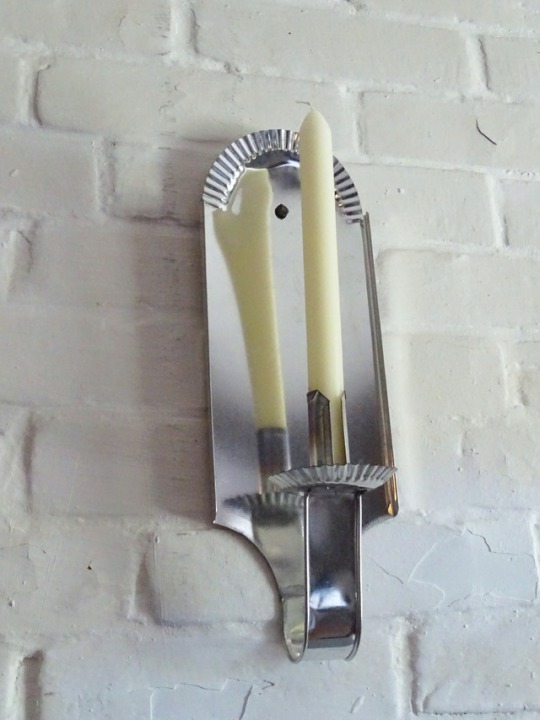
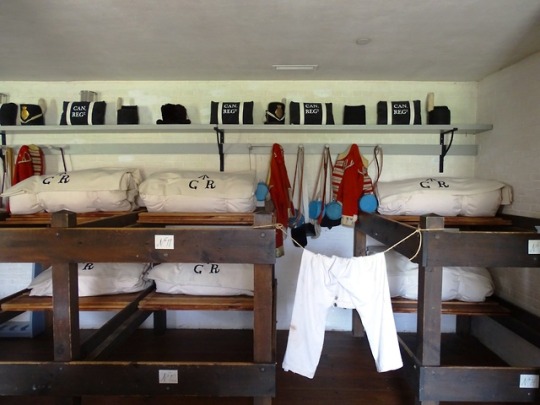
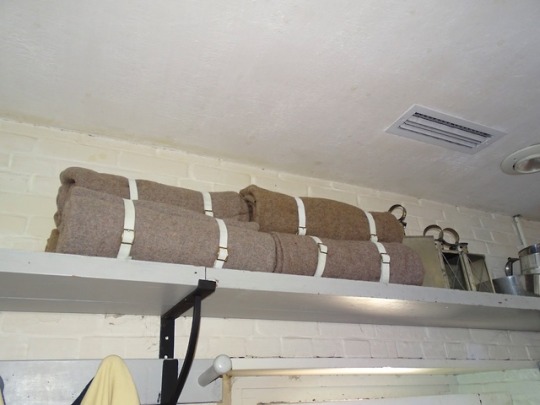


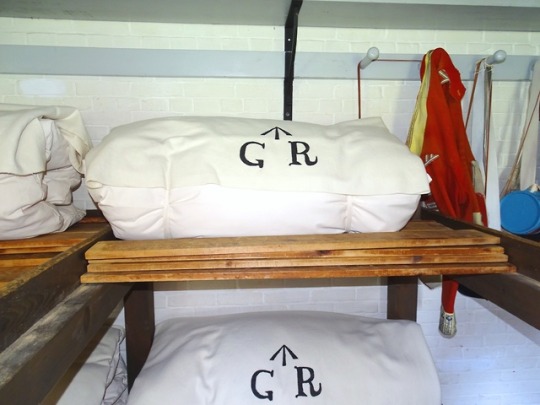
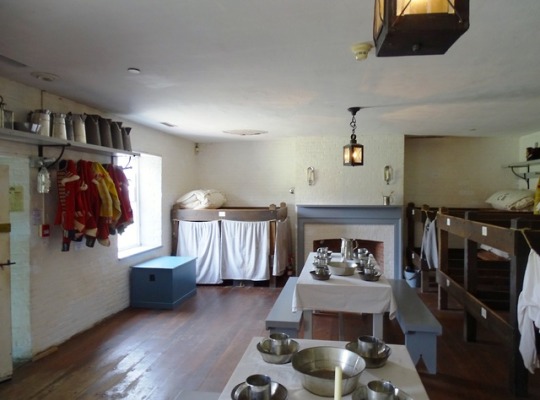


Fort York National Historic Site of Canada, Toronto (No. 3)
Living interpretation has occurred at Fort York since it was designated as a National Historic Site in 1934.
The Fort York Guard consists of a squad of musketmen (Fort York Squad) and musicians (Fort York Drums). Both groups wear the uniforms of the Canadian Regiment of Fencible Infantry which was garrisoned at Fort York in 1815. The Fort York Guard provides historical interpretation at Fort York during the summer months including music, musketry demonstrations, and the recreation of operating guns as detachments of Royal Artillery. The Fort York Guard is sponsored by the Friends of Fort York and Garrison Commons.
The Fort York National Historic Site was established on 25 May 1923, and houses Canada's largest collection of original War of 1812 period buildings. The bulk of its property consists of the area around the old fort. The National Historic Site includes a parcel of land east of Bathurst Street, as well as St. John's Square / Victoria Memorial Square to the northeast. It operates as a museum of the City of Toronto, offering visitors a number of services year round.
The fort's first cemetery at St. John's Square / Victoria Memorial Square is also part of the NHS. The second cemetery for the fort is also located in the Garrison Common section of the site. By the late 19th century twenty eight stones or wooden crosses marked graves, but there were hundreds of mounds. Headstones were later assembled into a memorial wall.
Each April, the site commemorates the US invasion of April 27, 1813, with walking tours, artillery and musket demonstrations, period cooking, and groups portraying units involved in the battle. During the summer months, the site comes alive with the colour and pageantry of the Fort York Guard, and is complimented with tours by professional historical interpreters. In the off-season, the fort is provides educational programs for tour groups including school, scout, guide, and day care groups.
Source: Wikipedia
#Fort York National Historic Site of Canada#Toronto#Ontario#Canada#travel#Fort York Heritage Conservation District#Old Fort York#museum#vacation#summer 2018#original photography#architecture#interior#table#1815 Soldiers' Barrack#cot#fireplace#uniform#coat#candle#lamp#lantern#blanket#old stuff#history#landmark#tourist attraction
1 note
·
View note
Photo










Public Art, Ottawa (No. 4)
The National War Memorial (titled The Response) is a tall, granite memorial arch with accreted bronze sculptures in Ottawa, designed by Vernon March and first dedicated by King George VI in 1939. Originally built to commemorate the Canadians who died in the First World War, it was in 1982 rededicated to also include those killed in the Second World War and Korean War and again in 2014 to add the dead from the Second Boer War and War in Afghanistan, as well as all Canadians killed in all conflicts past and future. It now serves as the pre-eminent war memorial of 76 cenotaphs in Canada. In 2000, the Tomb of the Unknown Soldier was added in front of the memorial and symbolizes the sacrifices made by all Canadians who have died or may yet die for their country.
Source: Wikipedia
The War of 1812 Monument is a bronze and stone memorial, located at Parliament Hill in Ottawa. Seven figures—a First Nations fighter, a Métis militiaman, a regular infantryman from the Royal Newfoundland Regiment of Fencible Infantry, a Quebec soldier of the Canadian Voltigeurs being bandaged by a female figure, a Royal Navy marine, and a farmer—represent those who took part on the Canadian side of the War of 1812.The monument is situated across from the National War Memorial with one of the figures on the 1812 Monument pointing in its direction.
Also part of the monument is a maple tree planted in soil taken from 10 Canadian battlefield sites and watered at the dedication with water from six oceans and lakes significant in the War of 1812. The tree symbolizes the Canadian nation that grew out of the effort to defend Canada during the War of 1812.
The Monument was dedicated on 6 November 2014, the 200th anniversary of the war’s final battle in Canada, the Battle of Malcolm’s Mills.
Source: Wikipedia
#angel charity by erin robertson#public art#ottawa#ontario#travel#canada#cityscape#original photography#summer 2018#landmark#evening#tourist attraction#the response by vernon march#dark clouds#national war memorial#sir wilfrid laurier by joseph-émile brunet#architecture#war of 1812 monument by adrienne alison#triumph through diversity#fire#centennial flame#close up#detail#water
6 notes
·
View notes
Photo

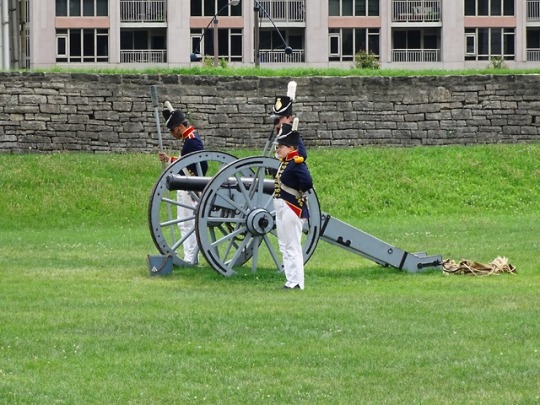
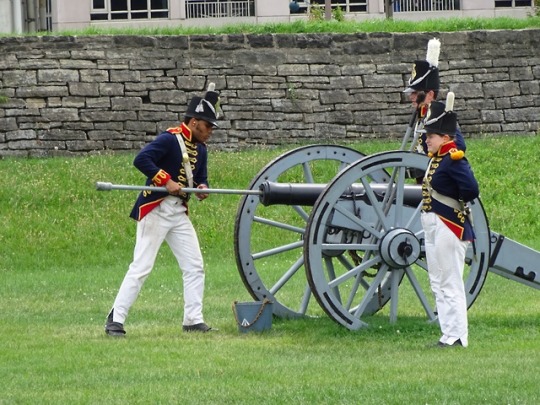
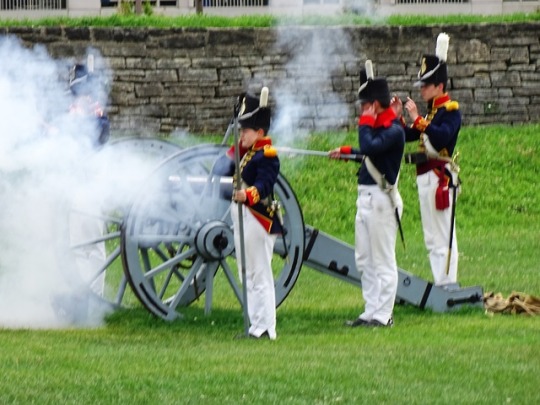
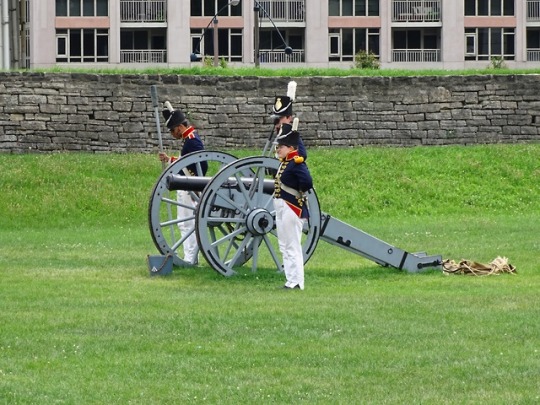


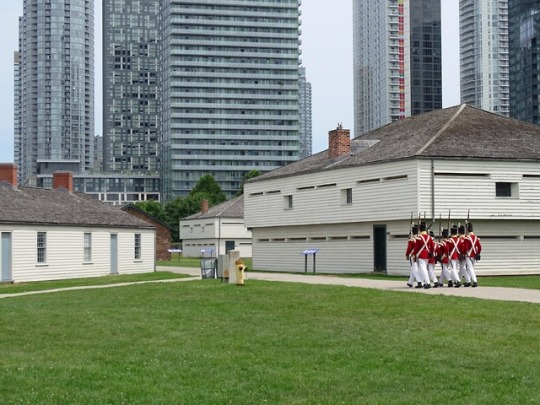

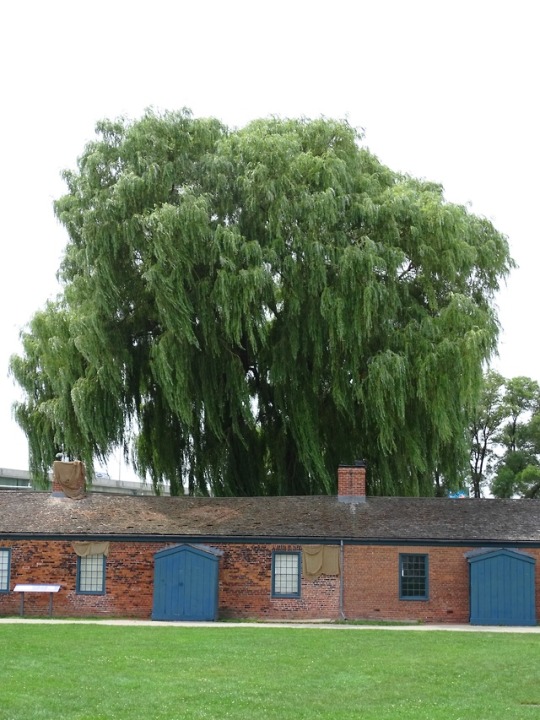
Fort York National Historic Site of Canada, Toronto (No. 9)
Uniforms
The Fort York Drums wears the uniform of the Canadian Regiment of Fencible Infantry, a unit that saw action throughout Canada during the War of 1812, and was garrisoned at Fort York in 1815. It is appropriate that the Drums should represent this regiment, as the fort that stands today was for the most part complete in 1815, and the entire regiment was garrisoned there. This regiment was a yellow-faced battalion, meaning that the regular infantryman wore a red coat with yellow facings (collar and cuffs). This colour distinction allowed commanders to distinguish between regiments, as every regiment was assigned its own facing colour.
The drummers of a non-Royal regiment wore "reversed colours." This means that their coats were yellow with red facings. This reversal allowed the drummers to stand out from the infantrymen. This distinction may have been due to the fact that a Corps of Drums was an object of pride for a regiment, and so it made sense to dress them differently. It is also a functional difference, as music was used to communicate with the army, so it was necessary to be able to identify the drummers quickly in garrison or on the battle field.
Each drummer (or fifer) was issued a fife case and sword. The fife case was likely a brass tubular case, worn over the shoulder and suspended by a belt. The sword was similar to the non-commissioned officer's sword of the period, and was suspended from a sword belt over the opposite shoulder of the fife case. The sword was intended as a symbol of importance rather than a weapon. In addition, many regiments gave their fifers and drummers the more traditional bear skin cap rather than the more common shacko. It is quite possible that the drummers of the Canadian Regiment had bear skin caps.
Muskets
The Fort York Guard carries the Brown Bess musket, which was the typical firearm of the British army during the War of 1812. The musket is one of the longest-used military firearms in history, remaining in official service between the mid 1700s up to 1839. It was a firearm that had many pros and cons, but it was an effective balance of technology and practicality.
Pros:
The musket could be loaded and fired relatively quickly. A well trained soldier could fire as many as three shots per minute, compared to only one or two shots per minute with a typical rifle of the period.
The musket was relatively cheap to mass produce.
The musket had interchangeable parts, which meant that if a part broke while in the field it could easily be replaced.
The construction of the musket was robust and durable.
Cons:
The musket was not particularly accurate. This meant that European soldiers fought in long lines and fired together en masse to maximize the effectiveness of the musket.
The misfire rate was high (estimates are as high as one in six shots misfired).
A musket is not accurate at distances greater than 100 yards. Close contact was necessary for deadly results.
Source
#Fort York National Historic Site of Canada#Fort York National Historic Site#travel#Fort York Heritage Conservation District#Old Fort York#Fort York Guard#Canada#Ontario#Toronto#vacation#summer 2018#museum#landmark#original photography#Fort York Squad#Fort York Guard Royal Artillery#6-pounder field gun#shacko#smoke#Gardiner Expressway#demonstration#military re-enactment unit#history#Officers' Blue Barracks#canon
0 notes